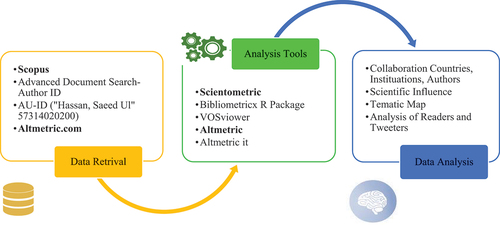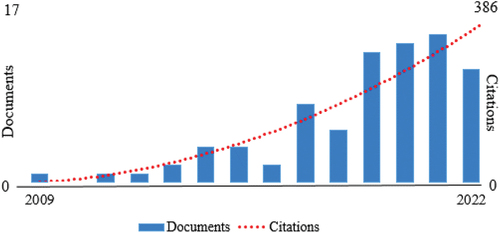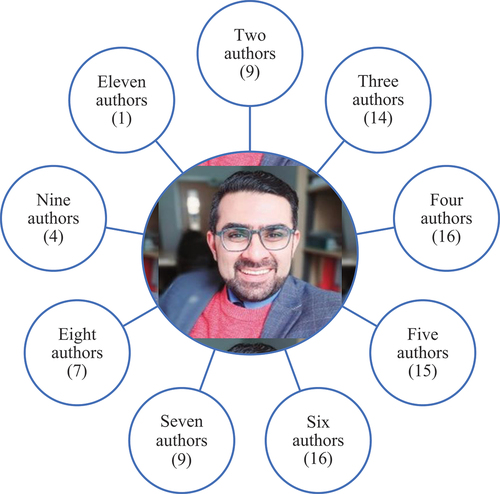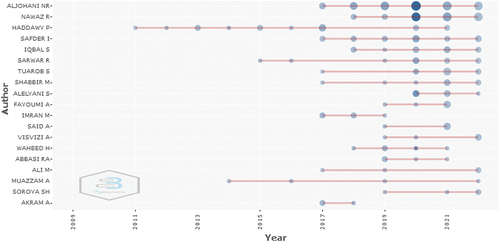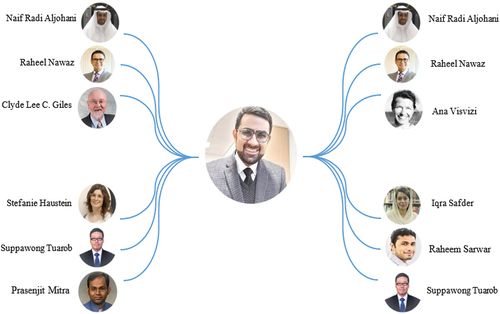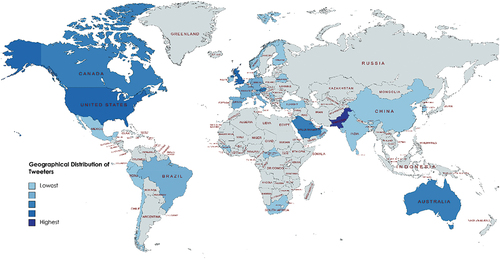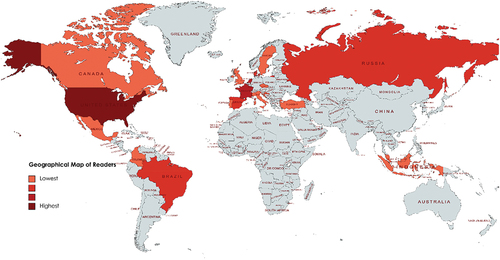ABSTRACT
This study highlights the scientific legacy and impact of Dr Saeed-Ul Hassan’s research on the world of science. He was a remarkable researcher in the fields of scientometrics, altmetrics, artificial intelligence, and data science, as evidenced by the Eugene Garfield Awards he received for innovation in citation analysis in 2017 and 2022. Based on datasets retrieved from the Scopus database for the years 2009–2022, he collaborated with 157 researchers from 22 different nations and his research findings are published in reputable journals and conferences. In the last five years of his life, his scholarly publications and scientific impact significantly increased. His significant attention to Open Access publications and high levels of worldwide collaboration have greatly contributed to his impact in the world of science. The results of altmetric studies indicate that Dr SU Hassan’s scientific publications are widely accepted by researchers on Twitter and Mendeley. The majority of individuals that tweeted and read his publications were from European and American nations. His research had the greatest impact on experts in the fields of scientometrics, computer science and social sciences, according to the classification of the readers of his research articles.
Introduction
Dr Saeed-Ul Hassan was Senior Lecturer in Artificial Intelligence/Data Science at Manchester Metropolitan University (MMU), England, and a former Chair of the Computer Science department at Information Technology University (ITU), Pakistan. He received his Ph.D. in information management in 2010 from the Asian Institute of Technology (AIT), Thailand, and was a former senior researcher at the United Nations University. He also worked as a Research Fellow at the Japanese National Institute of Informatics. Dr SU Hassan was the director and founder of Scientometric Lab, which is located in Pakistan. He was a prominent international specialist and researcher in the fields of scientometric and altmetric. His fame was largely attributed to scientometric and altmetric research, in addition to a large number of scientific publications and extensive computer science research. His research was recognized through twice receiving the Eugene Garfield award for “Innovation in Citation Analysis” from Thomson Reuters (now Clarivate Analytics) in 2017 and 2022 respectively. Clarivate is a global leader in providing solutions to accelerate the pace of innovation. This award is granted to an individual who demonstrates an innovative approach to scientific evaluation. His research interests included data science, machine learning, contextual scientometric, altmetric, bibliometric tools for evidence-based research policy formulation, information retrieval, and text mining. Prior to this, in 2009, he was also honored with the James A. Linen III Memorial Award for his remarkable academic achievements. Additionally, he was the winner of the National Institute of Informatics International Internship Program, which was awarded in 2008 and 2010 to the top MS student and finest doctoral candidate in the School of Engineering and Technology at AIT.
Numerous scientometric and bibliometric studies have been carried out in the past that looked at scientific publications from various angels (Hassan, Haddawy, and Zhu Citation2014; Noruzi et al. Citation2022a; Sarwar and Hassan Citation2015). Some researchers investigated the scientometric of journals (Gholampour et al. Citation2019). While others used scientometirc and bibliometric methods to assess the scientific standing of researchers (Elahi, Gholampour, and Dickson Citation2021; Gholampour and Noruzi Citation2021; Haustein and Peters Citation2020; Noruzi et al. Citation2022b). In this regard, in order to appreciate all the efforts of Dr SU Hassan, his scientific legacy and research impact were examined from two perspectives including scientometric and altmetric. This study reveals his favorite research areas as well as his research impact and international collaborations. In addition, an altmetric analysis was performed on his publications on social media (Twitter and Mendeley) to analyze the professional status and geographic location of users who paid special attention to SU Hassan publications. His scientific publication and citation status in the three bibliographic databases including Google Scholar (GS), Scopus, and Web of Science (WoS) are shown in .
Table 1. Publications, Citations, and H-index of Dr SU Hassan on Google Scholar (GS), Scopus, and web of science (WOS) (Extracted on 4 August 2022).
The rest of the paper is organized as follows. Section 2 presents the data and methodologies used to conduct this investigation. Section 3 presents results and discussion. Section 4 contains concluding remarks.
Methodology
In this section we describe the datasets used to conduct this investigation as well as the methods used to analyze the datasets.
Bibliometric data
We investigate Dr SU Hassan’s publications from the scientometric and altmetric perspective. The scientific publications of this prominent scientist were extracted from the Scopus database on August 4, 2022, using the AU-ID (“Hassan, Saeed Ul” 57314020200). The overview of the data collection process and the data analysis process is shown in . Finally, all 91 publications associated with him were carefully examined by the authors to confirm correctness of the data.
Altmetric data
The Altmetrics.com database was used to gather information about the readers of Dr SU Hassan’s’ publications as well as information about the readers’ geographic location, professional status and the subject area. To gather altmetric data, the altmetric database was searched for his publications with a DOI number. In general, 84 out of 91 publications in Scopus contained DOI identifiers whereas 7 publications did not have DOI identifiers. Among the publications with DOI identifiers, only 36 received an altmetric score and the other 48 publications did not receive an altmetric score. It should be noted that the data was extracted on August 10, 2022.
Data analysis
To achieve the objectives of this study, Bibliometrix R Package,Footnote1 and VOSviewerFootnote2 software were used to analyze scientometric data, and the altmetric online tool was used to analyze altmetric data. VOSviewer software was used to map Dr SU Hassan’s collaboration network and areas of interest, as well as countries, institutions, authors, and influential journals that published his scientific findings. In addition, relevant bibliographic information such as the research process, writing pattern, word cloud, and the trend of collaborating researchers were drawn according using the Bibliometrix R Package software.
Results and discussion
shows the bibliometric information of Dr SU Hassan between the years 2009–2022 in various scientific fields. The findings show that a significant amount of his research findings were published in the form of Journal and Conference articles, which constitute more than 98% of his publications. That is, 72 articles have been published in journals, 13 articles in Conference Proceedings, and 6 articles as Book Series (see , Part A). The results given in , Part B show that 78 articles were published in 38 journals and each article received an average of 13.24 citations. In this short academic time period, he used 297 keywords (DE) in his publications, and the keywords used by Scopus indexers (ID) to index his articles constituted about 564 keywords (Part C).
Table 2. Summary of the bibliometric information from Dr SU Hassan.
In terms of scientific collaboration, the findings confirm that he collaborated with 157 internationally based researchers, and all his publications were the result of collaborations. This shows his special attention to scientific collaboration (, Part D). In other words, the findings related to Authors Collaboration show that there are 1.72% Authors Per article and 5.07% Co-Authors Per article. His Collaboration Index was equal to 1.78%, which indicates that he had a good scientific collaboration status (, Part E).
The results also show that during 14 years of scientific activity, Dr SU Hassan published 91 articles which are listed in the Scopus database, of which about 78 articles (85%) were published in the last seven years of his academic career, i.e., 2016–2022. The productivity and scientific impact of this remarkable researcher of scientometric, altmetric, and artificial intelligence increased significantly while he was serving at Information Technology University, Pakistan (ITU) during the years 2014–2021. The results of show that the trend of his scientific publications in the last 7 years of his life (excluding 2018) has been on the rise. Examining the number of citations received shows that Dr SU Hassan had a unique impact despite his short academic career. This distinguished researcher received 1214 citations from his total published articles, of which 1185 citations (more than 97%) were recorded in the last 7 years of his life. Moreover, his citation average in the first seven years (2009–2015) was equal to 4.14 citations, and this amount increased fourfold (16.92%) in the last seven years. This investigation shows that he was at the peak of the scientific productivity and its impact between the years 2019–2022.
shows the co-authorship pattern of Dr Saeed-Ul Hassan. The minimum number of authors listed on his articles is two. We also note that his collaborative work entitled “Sentiment analysis for Urdu online reviews using deep learning models” involved 11 authors, and this is the highest level of his collaboration in a scientific project. This article was published in 2021 by Expert Systems and Dr SU Hassan was the corresponding author. Therefore, the patterns presented in have been the most common patterns in the research of Dr SU Hassan during his 14 years of presence in the scientific field.
and show his collaboration network at the country, institution, author, and journal levels. In general, his research team consists of 157 authors from 22 countries affiliated with 70 institutions. This co-authorship analysis shows his relevance based on the number of coauthors. He collaborated with researchers from all five continents. The highest proportion of his collaborators comes from Asian (70.43%), European (24.35%), and American (3.91%) researchers, and the lowest rate of his collaboration was with researchers from Africa (0.43%) and Oceania (0.87%) (). It is worth mentioning that his most active research collaborators include Naif Radi Aljohani, Raheel Nawaz, Peter Haddawy, Iqra Safder, Sehrish Iqbal, and Raheem Sarwar as shown in . Most of his collaborators in Asia come from Pakistan, Saudi Arabia, Thailand, and China. As for Europe, he mostly collaborated with researchers from England, Germany, and Greece. He also collaborated with researchers from USA, Canada and Australia. He had collaboration in Africa with Egyptian researchers. During his tenure at Information Technology University, his most active research collaborators were from King Abdulaziz University, Manchester Metropolitan University, and Mahidol University ().
Figure 4. The most prominent countries (a), authors (b), and collaborating institutions (c) in SU Hassan publications.
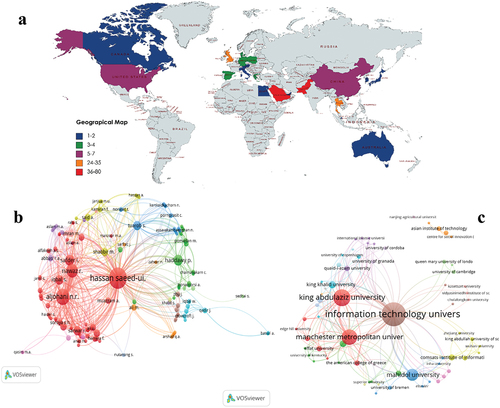
Table 3. Countries, institutions and prominent authors in SU Hassan Publications.
Dr SU Hassan’s research in the areas of scientometric, bibliometric, altmetric, social media (twitter), deep learning, machine learning, and citation analysis was mainly the result of collaborations with Pakistani researchers. He also collaborated on several topics such as bibliometric, altmetric, social media (tweeter), deep learning, machine learning, citation analysis with researchers from Saudi Arabia. He also worked in the fields of altmetric, deep learning, and machine learning with researchers from the United Kingdom, especially Prof. Raheel Nawaz.
Research findings by Dr SU Hassan have been published in 38 journals. He has been able to target this breadth of journals due to his expertise in a variety of scientific domains. The journals that were most prestigious to him are given in . This eminent scientist contributed 23 articles to Scientometrics. Additionally, the majority of his articles were published in journals associated with the fields of information science. The significance of Dr SU Hassan’s work in the fields of scientometric and altmetric appears to be one of the primary reasons for his publishing in these journals.
Investigation of Dr SU Hassan’s collaboration with researchers shows that Dr Naif Radi Aljohani started collaborating with him in 2017 and later became one of his most active collaborators. The first article they published together was entitled “Measuring Scientific Knowledge Flows by Deploying Citation Context Analysis using Machine Learning Approach on PLoS ONE Full Text” and they maintained their scientific collaboration until 2022. Their most active collaboration year was 2020, when they published their research findings in 10 different articles. In addition, this distinguished scientist started his scientific collaboration with Professor Raheel Nawaz in 2018, publishing their research findings in an article entitled “Mining the context of citations in scientific publications.” They continued this scientific collaboration until Dr SU Hassan’s sudden and unexpected death. In 2022 their collaborative efforts peaked, with 7 coauthored articles. Professor Peter Haddawy, a prominent Mahidol University scientist, was Dr SU Hassan’s longest collaborator, publishing 4 research articles with him between 2011 and 2021. Dr Iqra Safder is the fourth most active research collaborator of Dr SU Hassan. They started their scientific collaboration activities in 2017 and had continuous collaboration throughout the years. The peak of their scientific collaboration activities was in 2020 with 4 articles published in prestigious venues. The status of other colleagues of this scientist is shown in .
shows the authors, organizations, nations, and journals that Dr SU Hassan has influenced the most. His papers coauthored with Naif Radi Aljohani garnered the most citations followed by his coauthored papers with Peter Haddawy, Raheel Nawaz, and Iqra Safder. He received 944 citations during his tenure at Information Technology University, Pakistan (, Part B).
Figure 6. The most influential countries (a), institutions (b), authors (c) and journals (d) in SU Hassan Publications.
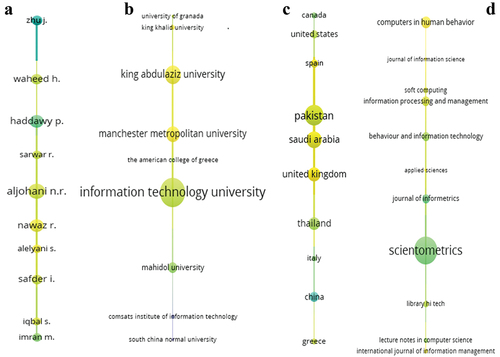
His work coauthored with researchers from Pakistan, Saudi Arabia, England and Thailand received the highest citations in terms of influential partner countries (Part C).
The articles coauthored by this eminent scientist on the topics of scientometric, bibliometric and altmetric had a significant impact on his scientific influence and credibility. In general, Dr SU Hassan articles published in Scientometrics received 563 citations, Computers in Humans Behavior received 101 citations, and Information Processing and Management received 67 citations (Part D).
Dr SU Hassan has worked on various topics in his short academic career. The size of the labels in and the size of nodes in show the extent of his attention to these scientific fields. The color of the nodes and the color spectrum used in represent the topics worked on in each time period of his academic career. The research topics investigated in the early years are marked with blue color and the recent years with light green and yellow colors. As seen in , most of his publications fall in the areas of deep learning, bibliometric, machine learning, altmetric, Twitter, algorithm search, and citation classification. also shows his favorite subject areas over the period of time. Based on , topics such as deep learning, machine learning, altmetric, twitter, sentiment analysis, social media, artificial intelligence, big data analysis, citation classification, and text classification have received more of his attention in these years.
Figure 7. Thematic areas explored by SU Hassan based on the keywords of publications in terms of frequency keywords and in terms of time.
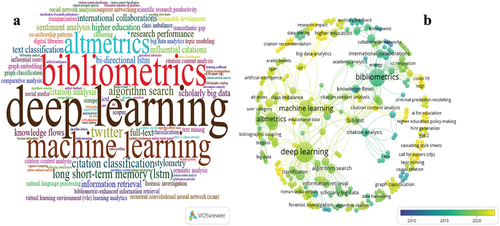
Dr SU Hassan was an expert in the field of artificial intelligence and data science (this can be seen from the size of the nodes in ). These are among the main topics that have always been foregrounded during the past fourteen years. On the other hand, his attention to bibliometric, scientometric, and altmetric has made him known as a eminent researcher in the field of scientometric and altmetric. It is important to mention that most of his scientific activities were in the field of scientometric and altmetric and were published in leading journals in the field of information science.
Dr SU Hassan published most of his research findings in journals affiliated with Springer Publisher (32.97%), as indicated in , and 16 (17.58%) papers in journals affiliated with Elsevier. The fields of scientometric, altmetric, artificial intelligence, data science, and information retrieval have been the focus of the majority of his research, which has been published in journals affiliated to these two publishers (, Part A). According to our authorship findings, he was the Corresponding Author in 47% of articles, the First Author in 27%, and the Last Author in 25%. It should be mentioned that he has received 519 and 699 citations from works published as first and the corresponding author, respectively. Additionally, Dr SU Hassan was both the corresponding author and the last author on some works, which is why his share of citations is higher than the sum of all citations received (, Part B).
Table 4. A summary of the publishing status and the status of Dr SU Hassan collaborations.
Dr SU Hassan has collaborated extensively with scientists from different regions of the world. Specifically, he has collaborated on several projects with 120 Asian researchers, 29 European researchers, and 6 American researchers. Some of the factors contributing to his high level of collaboration with Asian authors may be his long tenure as an Associate Professor at Information Technology University, his organizational affiliation with Asian institutions at various points in time, and his well-known scientific reputation in the fields of scientometric, altmetric, and artificial intelligence in Asia. His international participation, which is 55.44%, also demonstrates his specific interest in international collaborations. Additionally, Dr SU Hassan has worked closely with Pakistani academics at the national level. He sustained this scientific collaboration and included at least one Pakistani author in the majority of his works even after moving to Manchester Metropolitan University in England (from 2021 until the end of his life) as shown in , Part D. We note that, as for the coauthors who used two organizational affiliations, their organizational name used in the majority of their research was the basis to ascertain the authors’ geographic location.
Additionally, it was discovered that 58 (63.74%) of his articles were published in subscription right journals, while 33 of his articles were published in open access journals. Additionally, Dr SU Hassan has accumulated 458 citations from a total of 36.26% of the works he has released under an open access license. It’s crucial to note that 30 of his open access articles have been made available online. He was well aware of the positive relationship between open access publications and high research impact (Clayson, Baldwin, and Larson Citation2021; Tang, Bever, and Yu Citation2017) (Part C). More than half of his articles (i.e., 48) appeared in Q1 journals, and 19, 9 and 2 articles published in Q2, Q3 and Q4 ranked journals respectively, according to the findings in (Part E). He published 13 of his articles in conference proceedings. This distinguished researcher of scientometric, altmetric, and AI has received 975 citations from papers published in Q1 journals. However, the statistics from this section reveal that 86% of Dr SU Hassan’s publications were in high-ranked scientific journals (Q1 and Q2), and as a result, 97.28% of his citations are based on works that were published in these journals. The results of scientometric research revealed a considerable positive association between high-ranked journals (Q1 and Q2) and article citations; it appears that Dr SU Hassan gave this matter careful thought as well (Miranda and Garcia-Carpintero Citation2019).
depicts the information transfer and exchange between Dr SU Hassan and other scientists. Specifically, the Influencers are shown on the left side of the and the Influences on right side. The scientific ideas of scientists like Raheel Nawaz, his colleague and former professor at Manchester Metropolitan University and current professor at Staffordshire University, and Clyde Lee C. Giles, a professor at Pennsylvania State University and a former researcher, have had the greatest influence on Dr SU Hassan in the fields of artificial intelligence and data science. Professor Stefanie Haustein from University of Ottawa paid particular attention to Altmetrics, one of Dr SU Hassan’s favorite topics this year; he was also impacted by her scientific theories in the altmetric. Additionally, Raheel Nawaz, Ana Visvizi, and Naif Radi Aljohani have all cited Dr SU Hassan as having had the greatest influence on their research. Aljohani and Nawaz’s inclusion among highly regarded researchers is the result of their collaborative publications. Dr SU Hassan’s also shared research interests with Ana Visvizi, Iqra Safder, Raheem Sarwar, and Suppawong Tuarob.
Findings from Twitter revealthat 670 individuals tweeted the works of Dr SU Hassan, of whom 437 (65.22%) were located in 37 different countries. 41.19% of users were from Pakistan, followed by England, USA, UAE and Saudi Arabia with 4.93%, 4.03%, 1.79% and 1.49% users respectively. shows that the majority of users are found in Asia, Europe, and America. These users were Members of the public (563), Scientists (60), Science Communicators (35), and Practitioners (12). It should be noted that the geographic location of some tweeters and readers of publications was not known.
An investigation of Dr SU Hassan’s papers in Mendeley reveals that they have been read by scholars from 20 different nations, with a higher share of readers from the USA, Netherlands, and France than from any other nations. The proportion of the two continents, Europe and America, is higher than that of other continents Additionally, among the 2032 Mendeley readers, over 98% were of unknown origin (See ). ‘s data on the professions of Mendeley’s readers revealed that graduate students make up roughly 31% of the readers of Dr SU Hassan’s publications. Specifically, 397 readers were Doctoral candidates and 219 where Master’s students, making up the majority of these readers. Following that, 211 readers were Researchers and 72 were the Professors at different higher education institutions. The significant amount of interest from these groups can suggest that Dr SU Hassan’s writings have been of high quality and important for postgraduate students, researchers, and professors. The review of Dr SU Hassan publications in Mendeley shows that researchers from 14 scientific fields paid attention to his publications. Disregarding the 22% share of unknown scientific fields, readers from Computer Science and Social Sciences fields paid more attention to his publications than other fields. Therefore, one of the reasons for the attention of researchers in the two fields of computer science and social science can said to be that most of the publications of Dr SU Hassan were in the subject areas of bibliometric, altmetric, artificial intelligence, and data science.
Table 5. Subject field of readers (a) professional status of readers (b) and status of tweeters (C) of SU Hassan publications in Mendeley and Twitter.
Conclusion
The findings of this investigation demonstrate the excellence and stature of Dr SU Hassan as a scientometrician and data scientist. His publications show that he placed a lot of emphasis on scientific collaboration. With 1214 citations in a brief span of scientific activity and an H-index of 22 in the Scopus database, he has also had a significant impact on the scientific community throughout his brief academic career. His high levels of worldwide scientific collaboration have greatly contributed to his influence in the world of science. He has worked with 157 researchers from 22 different countries. He also paid significant attention to national collaborations. Until the end of his life, he worked on several scientific projects with 70 Pakistani researchers.
The results of altmetric studies indicate that Professor SU Hassan’s publications are widely accepted by researchers on Twitter and Mendeley. The majority of individuals that tweeted his articles were from Pakistan, England, and the United States. This demonstrates that his research has received major attention in both American and European nations. His research had the greatest impact on doctorate scholars and experts in the fields of computer science and social sciences, according to the classification of the readers of his works. Because the majority of his research efforts were focused on the topic of deep learning, bibliometric, machine learning, altmetric, and twitter, Professor SU Hassan gave close attention to the measuring disciplines of science and artificial intelligence.
Declaration of interest
This study relies on publicly available data and the informed consent statement is not applicable.
Acknowledgments
This study was conducted in tribute to Dr Saeed-Ul Hassan, a Pakistani Scientometric, Altmetric, and Data Science researcher, and a Eugene Garfield Award winner in 2017 and 2022. We will forever cherish his friendship and intellect.
Disclosure statement
No potential conflict of interest was reported by the author(s).
Additional information
Funding
Notes
References
- Clayson, P. E., S. A. Baldwin, and M. J. Larson. 2021. The open access advantage for studies of human electrophysiology: Impact on citations and altmetrics. International Journal of Psychophysiology 164:103–11. doi:10.1016/j.ijpsycho.2021.03.006.
- Elahi, A., S. Gholampour, and G. Dickson. 2021. A scientometric portrait of daniel funk: Publication productivity, collaboration patterns, and citation analysis. Library Philosophy & Practice 5352:1–18.
- Gholampour, B., and A. Noruzi. 2021. Scientometric portrait of Professor Wolfgang Glänzel, an expert in the field of scientometrics. Annals of Library and Information Studies (ALIS) 68 (2):198–207.
- Gholampour, S., A. Noruzi, B. Gholampour, and A. Elahi. 2019. Research trends and bibliometric analysis of a journal: Sport management review. Webology 16 (2):223–41. doi:10.14704/WEB/V16I2/a200.
- Hassan, S.-U., P. Haddawy, and J. Zhu. 2014. A bibliometric study of the world’s research activity in sustainable development and its sub-areas using scientific literature. Scientometrics 99 (2):549–79. doi:10.1007/s11192-013-1193-3.
- Haustein, S., and I. Peters. 2020. Commemorating Judit Bar-Ilan from bibliometric and altmetric perspectives. Scientometrics 123 (3):1211–24. doi:10.1007/s11192-020-03448-y.
- Miranda, R., and E. Garcia-Carpintero. 2019. Comparison of the share of documents and citations from different quartile journals in 25 research areas. Scientometrics 121 (1):479–501. doi:10.1007/s11192-019-03210-z.
- Noruzi, A., B. Gholampour, S. Gholampour, and C. Bianchini. 2022a. Bio-bibliometric portrait of mauro guerrini: An Italian specialist in knowledge organization and cataloguing. KO KNOWLEDGE ORGANIZATION 49 (2):87–97.
- Noruzi, A., B. Gholampour, S. Gholampour, S. Jafari, R. Farshid, A. Stanek, and A. Akbar Saboury. 2022b. Current and future perspectives on the COVID-19 vaccine: A scientometric review. Journal of Clinical Medicine 11 (3):750. doi:10.3390/jcm11030750.
- Sarwar, R., and S.-U. Hassan. 2015. A bibliometric assessment of scientific productivity and international collaboration of the Islamic World in science and technology (S&T) areas. Scientometrics 105 (2):1059–77. doi:10.1007/s11192-015-1718-z.
- Tang, M., J. D. Bever, and F.-H. Yu. 2017. Open access increases citations of papers in ecology. Ecosphere 8 (7):e01887. doi:10.1002/ecs2.1887.

